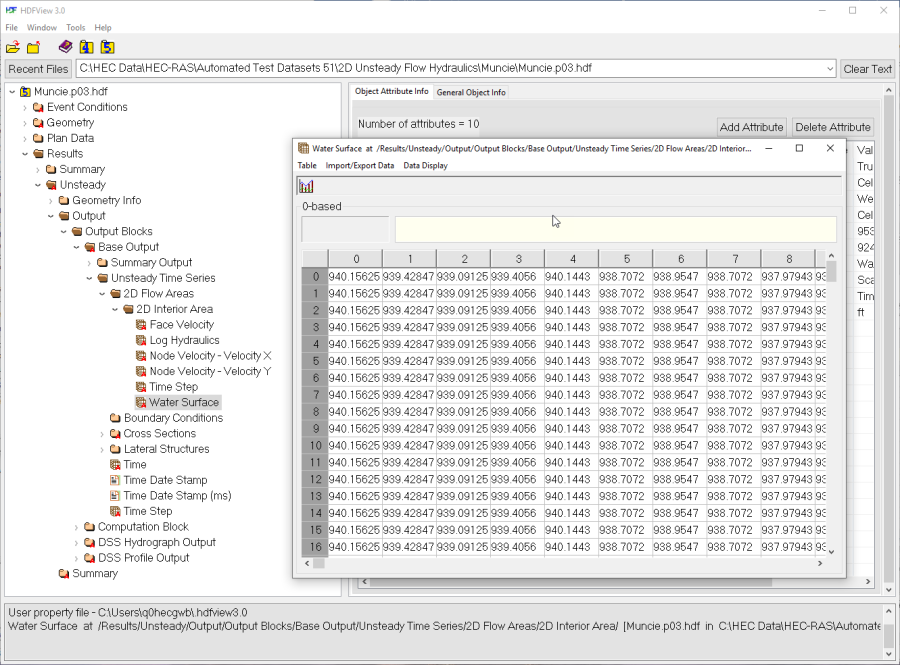The Output for the 2D flow area computations, as well as most of the 1D output, is contained in a binary file that is written in the HDF (Hierarchical Data Format) file format (The HDF Group, 2014). Similar to an XML document, HDF files are self-describing and allow users to specify complex data relationships and dependencies. However, unlike XML files, HDF files can contain many different types of data and all are stored in an efficient binary form. Furthermore, HDF allows direct access to different parts of the file without first having to parse the entire contents. Specifically, we are using the HDF-5 file format (Version 5 of HDF).
To view and or use some of the output outside of the HEC-RAS interface, the user can access it directly from the HDF files. A Free HDF file viewer can be downloaded from The HDF Group at the following location: https://www.hdfgroup.org/downloads/hdfview/ Download and Install the Windows 64-bit version. Once the HDF file viewer is installed you can open the files, view their contents, display tabular data, and even plot results. Shown in Figure 6-28 is an example HDF file output from an HEC-RAS 1D/2D model run. As shown in Figure 6-28, the user can get to the Unsteady flow output for the 2D areas (as well as 1D objects) by drilling down through the directories… Results/Unsteady/Output/Output Blocks/Base Output/Unsteady Time Series/2D flow areas/, then clicking on the folder name of the 2D flow area and the user can see all the output that was computed and stored for that specific 2D flow area. Currently available HDF file time series data that is output for a 2D area is:
- Water Surface:Water surface elevation for each cell (ft or m)
- Face Velocity: Normal face velocity (the component of the velocity perpendicular to that face) (ft/s or m/s)
- Time StepCurrent computational time step at that point in time.
In addition to the Unsteady Time Series output, there is also Summary Output. The Summary Output includes:
- Maximum Face Velocity: Maximum face velocity in the entire 2D area for each time step (ft/s or m/s)
- Maximum Water Surface: Maximum water surface in the entire 2D area each time step (ft or m)
- Minimum Face Velocity:Minimum face velocity in the entire 2D area for each time step (ft/s or m/s)
- Minimum Water Surface: Minimum water surface in the entire 2D area each time step (ft or m)
NOTE: The node velocities (Node X Vel and Node Y vel) are not automatically written to the HDF output file. HEC-RAS Mapper does not need these velocities to perform any of the mapping (It can compute the node velocities on the fly from the Face Normal velocities). If you want these velocities output to the HDF file you must go to the "Unsteady Flow Analysis" window, then select "Options", then select "Output Options". From here select the Tab labeled "HDF5 Write Parameters". Then check on the option labeled "Face Point (Node) Velocities".
There are several optional variables that can be written to the HDF output file. These include: Cell Depth; Cell center velocity; Cell flow balance (inflow minus outflow); Cell and Face Eddy Viscosity values; Face flow; Face WSEL; Face Tangential Velocity (both sides of each face); Face Shear Stress; and Face Point (Node) velocities. As you can see by looking at the file format, there is also time series output in this file for the 1D objects (cross sections, storage areas, lateral structures, inline structures, etc…). Over time all of the HEC-RAS binary output will be switched to HDF file format. For now the traditional ".O##" files are still written to and used for the post processing output, which users can view from the graphics and tables in the HEC-RAS interface. Even after HEC-RAS has switched over to using HDF, HEC-RAS will still fully support DSS (import of data and user selected output of results).
